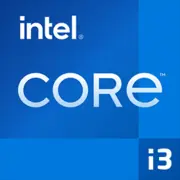Intel Core i3-12100T

インテル Core i3-12100T: オフィスやマルチメディア用の予算向けプロセッサ
2025年3月
イントロダクション
インテル Core i3シリーズのプロセッサは常に予算PCのスタート地点でしたが、モデルi3-12100Tはこの中でも際立っています。ハイブリッドアーキテクチャのAlder Lakeを基に設計されたこのチップは、日常的な作業に十分なパフォーマンスを持ちつつ、低消費電力を実現しています。2025年現在、オフィスシステム、メディアセンター、コンパクトなビルドにおいても依然として有効です。その理由を見ていきましょう。
主な特徴
Alder Lakeアーキテクチャとインテル7プロセス
i3-12100Tは、ハイブリッドコア(PコアおよびEコア)が初めて導入されたAlder Lakeアーキテクチャを基にしています。しかし、このモデルには4つのPコア(8スレッド)のみが搭載されており、Eコアはありません。このため、構造が簡素化され、コストが下がっています。インテル7プロセス(10nm Enhanced SuperFin)は高いエネルギー効率を提供しており、基本TDPはわずか35Wです。
パフォーマンス
- クロック周波数: ベースは2.2GHz、ターボモードの最大は4.1GHz。
- キャッシュ: 12MBのL3。
- グラフィックス: 統合GPU Intel UHD Graphics 730(ベースクロックは300MHz、ダイナミッククロックは1.45GHz)。
- ベンチマーク: Geekbench 6では、シングルスレッドで1935ポイント、マルチスレッドで5793ポイントを記録しています。比較として、これはインテル Core i5-10400(Comet Lake)と同等のスコアですが、TDPが少ないです。
主な特徴:
- PCIe 5.0のサポート(新しいSSDとの最大互換性)。
- インテルスレッドディレクター技術(Windows 11用のスレッド最適化)。
- 脆弱性からのハードウェア保護(シャドウスタック、コントロールフローメンフォースメント)。
互換性のあるマザーボード
LGA 1700ソケットとチップセット
このプロセッサはLGA 1700ソケットを使用しており、次のチップセットと互換性があります:
- H610 — 予算向けオプション(DDR4、PCIe 4.0、オーバークロックなし)。例: ASUS Prime H610M-E ($75-90)。
- B660 — 最適な選択(DDR4/DDR5、GPU用のPCIe 5.0)。例: Gigabyte B660M DS3H ($110-130)。
- H670/Z690 — エンスージアスト向け(USB/SATAポートやメモリのオーバークロックが増加)。
選択の特徴:
- i3-12100Tには高価なZ690を選ぶ意味はありません — チップはオーバークロックをサポートしていません。
- DDR5が必要な場合は、この規格をサポートしているB660を選択してください(例: MSI PRO B660-A DDR5)。
サポートされるメモリタイプ
このプロセッサは以下のメモリに対応しています:
- DDR4-3200(安価なモジュール、例えば、Kingston Fury Beast 16GB — $40)。
- DDR5-4800(より高速ですが高価: Corsair Vengeance 16GB — $70)。
推奨:
- オフィスの作業やマルチメディアにはDDR4で十分です。
- DDR5は、ゲームやグラフィック作業用のディスクリートグラフィックカードを搭載したビルドにのみ合理的です。
電源ユニット
TDPが35Wのi3-12100Tは、最も「経済的な」デスクトッププロセッサの一つです。しかし、次の点に留意することが重要です:
- ディスクリートグラフィックカードなしのシステム: 300-400Wの電源ユニットで十分です(例えば、be quiet! Pure Power 11 400W — $60)。
- NVIDIA RTX 3050相当のグラフィックカードを搭載する場合: 500-600Wの電源ユニットが必要です(EVGA 600 W1 — $65)。
重要: たとえFSP Hyper 500W ($45)のような弱い電源ユニットでも対応しますが、安価なものに頼るのは避けた方が良いです(安定性のリスクがあります)。
長所と短所
長所:
- エネルギー効率: コンパクトなケースやパッシブ冷却システムに最適。
- 高いシングルスレッド性能: ブラウジングやオフィスアプリケーションでの応答が速い。
- UHD 730の搭載: 低設定(720p、40-50 FPS)でCS2などのゲームがプレイ可能。
短所:
- コア数が4つしかない: 2025年にはレンダリングやストリーミングには不足。
- SSD用のPCIe 5.0をサポートしていない(PCIe 4.0 x4のみ)。
- オーバークロックをサポートしない。
使用シナリオ
オフィスとマルチメディア
- ドキュメント作成、ビデオ会議、4Kストリーミング(Netflix、YouTube)がスムーズに行えます。
- 例: HDMI 2.0を介して4Kモニターに接続。
ゲーム
- ディスクリートグラフィックカード(例: NVIDIA GTX 1660 Super)を使用して: Fortniteは中設定で(1080p、60 FPS)。
- グラフィックカードなし: MinecraftやDota 2(720p、30-40 FPS)。
作業タスク
- フォトエディタ(Lightroom)では、RAWファイル処理がi5-12400に比べて15-20%長くかかる。
- プログラミング: IDE(VS Code、IntelliJ)で快適に作業。
競合との比較
AMD Ryzen 5 7500F ($140-160):
- 長所: 6コア、DDR5サポート、マルチスレッドタスクでのパフォーマンスが高い。
- 短所: 組み込みグラフィックスなし、TDP 65W。
インテル Core i5-12400T ($180-200):
- 長所: 6コア、より高い周波数(4.6GHz)、ゲームに適している。
- 短所: 価格が40%高い。
結論: i3-12100Tは、予算セグメント($150以下)および低TDPの要求においてのみ強みを持っています。
ビルドに関する実用的なアドバイス
1. マザーボード: アップグレードの予定がなければ、DDR4対応のB660を選んでください。例: MSI PRO B660M-A WiFi ($130)。
2. 冷却: ボックスクーラーで十分ですが、静かな動作を求めるならDeepCool Gammaxx 400 V2 ($25)を選んでください。
3. ストレージ: NVMe SSDが必須です(例: Kingston NV2 500GB — $35)。
4. ケース: コンパクトなビルドにはFractal Design Core 1100 ($50)が適しています。
総括: i3-12100Tは誰に向いているか?
このプロセッサは以下のような方に最適です:
- オフィスPCまたは家庭用メディアセンターを構築している。
- エネルギー効率を重視している(例えば、ミニPCやサーバー用)。
- 予算が制約されている(プロセッサが$120-140、全体のビルドが$300-400)。
2025年において、i3-12100Tは低価格と基本的な作業に対する十分なパフォーマンスによって依然として有効ですが、ゲームやプロフェッショナルなワークロードには6コアのモデルを検討する方が良いでしょう。
基本
CPUの仕様
メモリ仕様
GPUの仕様
その他
ベンチマーク
他のCPUとの比較
ソーシャルメディアで共有する
または当サイトへのリンクを追加
<a href="https://cputronic.com/ja/cpu/intel-core-i3-12100t" target="_blank">Intel Core i3-12100T</a>